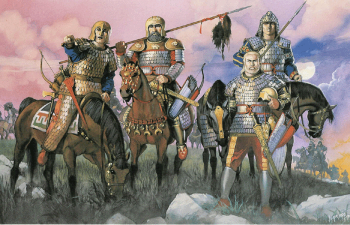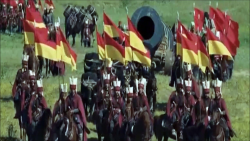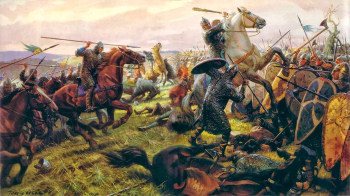History of Elwynn
A History of the Elwynnese Union from the earliest times up until the year 1623 (Elw Calendar) and the beginning of the current era. Written 'in-sim' and from a secular perspective, accounting for religious beliefs and interpretations where known or advised of. Hyperborean events are mostly excluded except where they impact upon the mainland. Similarly the overseas realms incorporated into the Elwynnese Union are only to be addressed when of relevance during the independence era.
Contents
Authorship
The History of Elwynn was first written down by the Irijah Prosper Arturion (1545-1624), a noted scholar and antiquarian famous for his boast of visiting each and every single one of the Bailiwicks of the Elwynnese Union.
His life's work was mostly a continuation and elaboration of the Histories of Ric Lyon interwoven with anecdotes relating to the various towns. After his demise the manuscript was unfortunately lost, however the Vice-Dean of the Library and academicians of the Alôqoqar Etâqon Adurellion are attempting a reconstruction of the work based upon the accumulated mass of research notes and the charred remains of the original tome.
History
Antiquity
In mythology Utas, the Treesian God of Light, was believed to have brought the deity known as Elwynn to this area, which since ancient times is considered the primary source of the River Elwynn. Tradition attributed to him also the construction a tower at a spot of the banks of the aforesaid Great River of Benacia to protect the Goddess from the attentions of her twin brother Lest. The Tower of Araxion, named after its site is noted for its prehistoric foundations and as such can be considered one of the earliest stone structures on the continent.
There is some belief amongst Antiquarians and Ethnographers that the legends that have grown up around the Tower are a reflection of the role Araxion played in the prehistoric development of the proto-Elw 'Culture Groups'. It was from this ancestral homeland that the Elw, first as hunter-gatherers and then as pastoralists, would eventually expand outwards to dominate the north of Benacia, and in so doing give rise to the myriad tribes and warbands that would cause the early Shirerithian Kaisers such consternation that they were obliged to site their Imperial Capital at Shirekeep in order to defend and ultimately - at the expense of much blood and treasure - pacify the region.
Cimmerians, from the islands of Cimmeria on the north-eastern shore of Benacia, attacked Elwynn with increasing frequency and held various points along the northern coast. This went back and forth for a while until Cimmeria was granted county status as part of Hyperborea.
Mediaeval Period
1356: Kaiser Raynor I unites Brookshire and Goldshire, invades Elwynn. In the Battle of Shirekeep, he occupies the Elwynn fork. Elw tribes bravely battle on.
1443: Imperial Republic of Shireroth founded with Erik II as kaiser.
1454: Duchy of Elwynn established, initially known as Northshire and not extending far beyond a fortified pale (area enclosed by a palisade) around Shirekeep.
1469: Hyperborea annexed to Elwynn as barony.
1478: Eros Darkstar appointed Bard of Elwynn. Hyperborea under Kalir Sethan reaffirms its allegiance to Elwynn and Duchess Mari Greenwood.
1484: First elections held in Elwynn. Austi Scot, baron of Novi Dalmacija, builds a statue in honour of Mari Greenwood in Novi Dalmacija.
1487: Kaiser announces plan to demote Elwynn from duchy-status to barony-status and give Hyperborea duchy-status. The Duchy government completely rejects the plan. Hyperborea offers compromise. Kaiser rejects compromise and reiterates his plan. Landsraad votes to demote Elwynn. Elwynn established as barony under the Duchy of Hyperborea.
The reduction of the Elwynnese nobility during the wars of conquest, the introduction of the Elfinshi under the nos Fëanor and Greenwood dynasts during the 1470's followed by the subsequent downfall of those Elvish houses during the looming Babkhan era would play a key part in forming the ultimately egalitarian nature of the Elw majority. The destruction of the indigenous landowning and warrior castes prevented the formation of a stratified aristocracy and led to the significant noble families that arose in the subsequent eras, Kalir, Osman, Ettlingar Freyu (Hyperborean, Babkhi and Froyalanish respectively) deriving from immigrant stock.
1st Babkhan Era
1488: Mari Greenwood abdicates in favour of Ardashir. First Babkhi epic on Lest published. Great Osmanid Charter proclaimed. Greenwood and entourage emigrate to Delvenus. Order of the Dead Stag established. Capital punishment reinstated, Hyperborea responds by putting Ardashir under house arrest and overturning all baronial laws, then occupying all of Elwynn. Civil War ensues. The Duke Rulak of Hyperborea (Locke) then further dissolves the Order of the Dead Stag. The Babkhan Shah made a diplomatic protest on behalf of his kinsman and the Kaiser responded by saying it's a ducal matter, pledges neutrality. Considered the year of Elfinshi genocide.
1489: Cease-fire called by Ardashir. Elf molestations, kitten drownings and puppy burnings are all halted (or at least suspended for the moment). Ardashir's rule restored.
1494: Donation of Elwynn. Temples of Cedrist worship to Ryvenna and B'caw established in Elwynn. Today's Ryventemple and B'cawshrine.
1495: Halluci dragons are battered by multi-national artillery before the East Elwynn Sluices, flee into Goldshire.
1496. Diplomatic crisis with Goldshire over the White Elwynn. Baron blames Goldshire for river piracy, orders cleansing of river.
1497: Military engagements with Goldshire.
1500: Elwynn is transferred to Arminian rule under the Barony of Hurmu.
1502: First mention of the emergence of cults that would later form the Holy Church of the Divine Icebear.
1504: Elwynn becomes a Barony under Brookshire as the Barony of Elwynn and Lac Glacei, with David Northworthy Beckford as its Baron.
1506: Genocide reconciliation and commemorations begins in Richard Lyon's tour d'Elwynn. 1508: Richard Lyon succeeds David Northworthy Beckford as Baron of Elwynn and Lac Glacei. Umra Mosque opened in Eliria. Yardistan declares war on Elwynn for lack of collective punishment against the Babkhi community for the Elfinshi genocide. Baron Lyon forms militia. Halluci mass immigration to Illumination begun (along with dragons).
1509: Elwynnese borders closed to all but citizens of Elwynn, Lac Glacei, Brookshire, Amity, Mirioth, the Grand Commonwealth, Stormark, Cranda and Hallucination. County of Port Illumination established. Amir Osmani makes the Triumphant Folk speech, calls for boycott of Brookshire (under which Elwynn is a barony). Lesser Zjandaria established as Babkhi county (Ardashirshahr, Caligae and Vijayanagara Communes). Lady Vesteralen made a citizen of Elwynn (Not Shireroth) by Baron Lyon, provokes imperial government and married her. Elwynn raised to duchy, celebrations across the country, meanwhile protests in other parts of Shireroth against the foreignness of Elwynn, boycotts of Elwynnese products. Peace treaty between Yardistan and Elwynn.
1510: Duke holds discussion with nobles whether to join MSX (a flawed but briefly popular banking system), gets Imperial Smackdown (a form of direct intervention popular in the autocratic period). Creation of Counties of Lac Glacei, Araxion, Eliria and Utasia, and Íseirdia-la-Vraulalennir. Count Ozarka sues and indicts Lord Bill of Antya over a sexual slur. Chief Justice Davis hears case, then leaves it for lacking merits. Cease and desist order from Kaiseress Semisa on Vasroie's activities (Matthew Basil. Co-Baron of Port Ill. Byz.).
1511: Lac Glacei ceases to be a part of Shireroth, and as a consequence ceases to be a part of the Duchy of Elwynn too, under the provisions of the Centerflying Treaty.
1512-1533: The Great Famine.
1514: Chief Justice Rob Davis dies.
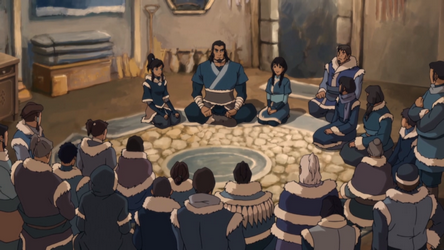
1516: Harald of Ettlingar Freyu is granted the County of Wintergleam by Kaiser Alejian II. In exchange for the county grant the former builds the latter a castle-like house on the coast of Wintergleam, which is to this very day known as Alejian Castle.
1526: Andelarion inherits the throne of the Kingdom of Babkha as "Rashid Shahanshah".
The Babkhan era saw a marked socio-economic change in Elwynnese society. In the attitudes of the period the emphasis was on sins originating from economic motives, characterised by the depiction of Mari Greenwood and her retainers as the personifications of unearned reward. The welfare of the human community being prejudiced by the avarice and irresponsibility of the Elfinshi ruling classes. Ironically it was the arrival of Babkhan migrants, at the instigation of Hyperborean and Treesian interests, which saw the greatest upheaval, with the introduction of heavy industries such as gunpowder mills and iron works into what had previously been an agrarian and rural idyll sustained - at least in the Froyalanish telling - by the favour of the Goddess Elwynn herself and the suffused magic of the Elfinshi themselves.
In their place came a rough-hewed crew of Babkhan ghazis - holy warriors of the Zurvanist faith - merchants and engineers, all hungry for resources and land. Those who lived through the times perceived a catastrophic social and economic crisis arising from the wars of the late 1480's and the 1490's where the mortality rate approached 30% in some areas, causing a desperate shortage for the farms and the factories. In the next decade incomes for the surviving Elw peasants rose dramatically prompting socially repressive laws aiming to keep the peasantry tied to their places of work. A particularly harsh example was the Forestry Law promulgated by Baron Ardashir which can still be found within the Elwnameh body of customary law in Alalehzamin. The Forest of Elwynn itself was rapidly diminished during this period, with trees being felled for construction projects such as the damming of the West Elwynn and the construction of the East Elwynn Sluice as well as a doomed effort by Baron Ardashir to build two causeways by which an invasion of the Cimmerian Isles might have been mounted. In addition to these vainglorious projects the ever ravenous demands of industry for fuel and timber saw ever greater numbers of trees felled.
In spite of new tracts of land being opened up by deforestation to ever more intensive forms of agriculture imported from the Euran continent the export of grain back to the Kingdom of Babkha produced the desperate hunger famine of 1512-1533. The Babkhan settlers, faced by falling rent-rolls and deserted holdings, pressed their tenants harder still.
Insurrection however was, ironically enough, prevented by the efforts of Brookshire, Yardistan, Kildare and Goldshire to evict the 'foreigners' from the realm. The Elw had always considered themselves to be a people apart and when faced by their Southern neighbours, advancing as liberators, made common cause with the Babkhi and with the growing community of Stormarkers in Wintergleam who would eventually come to be regarded as the Froyalanish and the Haraldian Wintergleamish. This culminated during the so-called War of Vengeance when Count Harald of Araxion, and his battle-hardened retinue of Huskarls formed the core of the army that threw back the Antyan invasion fleet in the Battle of Vijayanagra, one of the decisive engagements of the war.
This destructive period nonetheless saw the first commencement of Elwynn's struggle towards modernity that, within a century, would see an industrialised society arise from the ruins of the mediaeval world. Elwynn would cease to be a backwater and take its place at the top table of Shireroth.
The Froyalanish Era
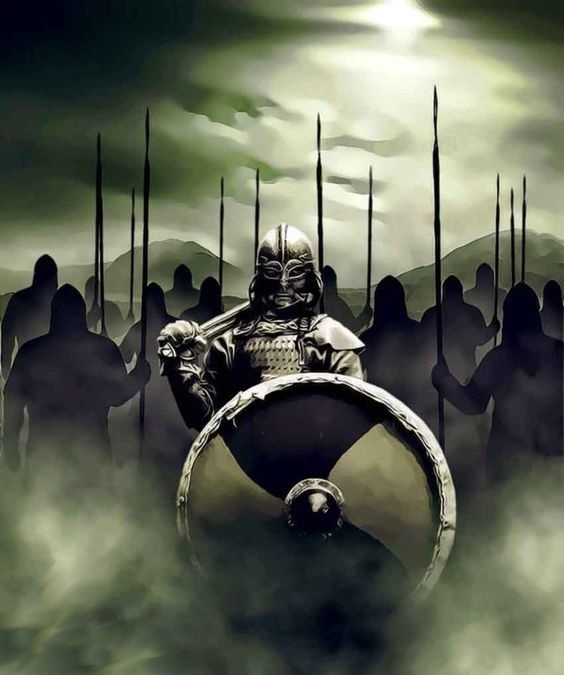
1533: Kaiser Mors V appoints Count Harald of Wintergleam to the White Orchid Throne and the latter becomes the Twelfth Ruler and Seventh Duke of Elwynn. Elwynn changes name to Froyalan. A security force with Duke Harald's Huskarls as its core commences with restoring law and order. Shipments of food from Gascony as well as Port Chloe and the Providence Plantations, two foreign Duchies which are also held by Harald of Ettlingar Freyu, provide famine relief.
1534: Duke Harald repeals all legislation which is in force in Froyalan and abolishes all offices in the Duchy, save for the office of Duke of Froyalan. Reinstatement of ducal decree by Duke Richard Lyon that abolished slavery, thraldom and indentured servitude. Duke prohibits grain exports to Babkha. Famine comes to an end.
1535: Commencement of Tapferite immigration to Froyalan. Duke decrees that Froyalan is to be divided into the following Counties: Hyperborea, Wintergleam, Bjorngard, Cimmeria, Eliria and Utasia, Smjörkýr, Illumination, and Lesser Zjandaria and (re)assumes the County of Wintergleam. Richard Lyon, Carol Reeves and Nathan of Natopia inducted to the House of Ettlingar Freyu (Shireroth branch) as Rikard of Ettlingar Freyu, Carol of Ettlingar Freyu and Sigurd of Ettlingar Freyu, as well as rights of succession to the White Orchid Throne vested in the Ducal House aforesaid. Richard Lyon, Nathan of Natopia and Ardashir Osmani appointed counts of Eliria and Utasia, Smjörkýr, and Lesser Zjandaria, respectively. Legislation concerning the Donation of Elwynn of 1820 and the Monument Law of 2024 reinstated, both dates in ASC, ar the petition of Count Richard of Eliria and Utasia. Løgting of Froyalan established, called to session, and its session opened with a ritual of the faith which would over time would become to be known as the Froyalanish Ancient Ways. Asgard calendar made the official calendar of the Duchy of Froyalan. K'Tzuni bombs the West Elwynn Dam, Løgting contemplates war. Ducal Decree issued that made all residents of the Duchy of Froyalan, regardless of their race or ethnicity, equally eligible for appointment to public service.
1536: Hesam Jahandar named Count of Hyperborea. Ducal Decree issued to formalize the vast array of sweeping powers possesed by the Duke of Froyalan under the Udal Law to protect individuals from harassment, bullying and other forms of harm inflicted by heinous, unruly and subversive elements. Counts given power to deport individuals from their Counties. Duke names Freyja patron goddess of Elwynn/Froyalan, the people respond by mass-demonstrations; some in favour, some against. Araxion repatriated by Duke Harald. Creation, at the initiative of Duke Harald, of the Baronies of the Elw, Fórntida Kærleikalanden, and Opplysta Smørvirket by the Landsraad.
1537: Duke Harald becomes the Baron of the Fórntida Kærleikalanden. Richard Lyon is appointed Baron of the Elw, Nathan of Natopia is appointed Baron of Opplysta Smørvirket.
1539-1542: The Duke is largely away from Froyalan, fighting in the war over Bosworth - which is known as the War of Jeremy's Nose/Redoubt Island War/Gascon Campaign and in which the "Elwynnbrigaden" defence force plays a key part - for which he was awarded the title King of Bosworthians by Kaiser Hasan I.
The Froyalanish Era is one of the most significant periods in Elwynnese history.
It all started in the dark days of desolation which is known as the Great Famine when Kaiser Mors V - who was spearheading the renaissance of Shireroth - turned to Count Harald of Wintergleam, the last remaining high noble in the Lands of the Two Sacred Rivers, who was seen as the only chance to fight the chaos zone that the Duchy of Elwynn had become, and after His Niftiness was advised by Count Harald that he was willing to ascend the White Orchid Throne he named him Duke of Elwynn.
Quite shortly after ascending the Ducal Throne of Elwynn, with the encouragement of the Kaiser and to give it a fresh start, Duke Harald changed the name of the Duchy to Froyalan. Duke Harald then embarked on a forceful campaign to fix his Duchy's ails and woes in which he picked it up, shook it up, turned it around, and forged it into something new - policies which did not came without opposition.
Those policies, though, bore fruit quickly. The famine was ended by food shipments from Gascony as well as Port Chloe and the Providence Plantations and the prohibition of grain exports to the Kingdom of Babkha. A security force with Duke's Harald's Huskarls at its core manage to restore law and order by jailing, executing, and driving out of the country the innumerable criminal gangs, warlords and other thugs who were rampaging country. Tapferite and proto-Froyalanish immigration to Froyalan brought advanced technology, funds and other resources into the Duchy - combined with the restoration of law and order - resulted in infrastructure and essential services being restored, and agricultural and industrial output getting back to pre-Great Famine levels in no time and remaining on a steady rise after that.
Duke Harald's Reign, especially the renaming of the Duchy to Froyalan and the upsurge of Vikingness - which was deeply permeated in his rule - had a tremendous impact on the Elwynnese Nation, causing all segments of Elwynnese society to soul-search what it is to be Elwynnese. Ironically, and very much to the dismay of Shirekeep, renaming Elwynn into Froyalan only fueled Elwynnese nationalism further. Another example of this is the adoption of the Asgard Calendar - designed to allow the duchy to move away from the ASC Calendar - which spurred the Elwynnese into developing a calendar of their own, which resulted in the creation of the Elw Calendar.
The wild debate that his reign brought, inspired Duke Harald to organize the Løgting of Froyalan, which in effect evolved to an Elwynnese legislature until the end of the duchy. He is also remembered for the significant corpus of law that was established by him and his creation the Løgting, which after his reign became the Council at Eliria and was the predecessor of future Elwynnse legislative assemblies such as the Senate of Elwynn and the Royal Parliament.
So the Elwynnese of today have him to thank for their recent history of organized government (with legislatures, corpuses of laws, etc), and for bringing patriotism and a non-political, deep love for their country.
Upon his abdication, which came quite unexpectedly, Duke Harald was showered with praise for the excellent job he had done during his near-decade at the helm of the Froyalanish ship of state, presiding over the expansion of Froyalan into probably Shireroth's largest and most active Duchy. During his long Reign - at the time the third longest Ducal Reign - he had also managed to keep his duchy - with many disparate ethnicities - stable, peaceful and prosperous, something which was viewed as a great feat.
Another great feat by him was the reclaiming of Araxion, which Shireroth had bargained away in the Atkins Reduction one-and-a-half decade earlier, succesfully taking on a belligerent mob of outlandish haters who regarded Shireroth as a land-hoarding behemoth and who used every trick in the book to thwart his attempts to claim Araxion back for the duchy, but the haters were skillfully outmanouvered by Duke Harald and those most sacred lands of the Tower County finally returned, after so many years in the desert, to the bosom of the White Orchid Goddess.
2nd Babkhan Era
1542: Duke Harald abdicates, Kaiser Hasan (Hesam) succeeds. Elwynn is restored as name of the duchy. Hasan is shot by Ardashir in Ardashirshahr, Rashid Andelarion succeeds as Kaiser Ayreon. The episodic Ayreon- Loki Civil War that will define Elwynnese public life for the next sixty years begin over the disputed succession to the Golden Mango Throne. Initially the Ayreonist faction prevails. Byzantopol, a city founded by Jahandar exiles employed by Automat Inc. emerges in Bjorngard as a self-regulating polity (robocracy), a precursor to the Raikothian system of Oracles and the modern Coordinated State. Some consider this to be rather disconcerting.
1542-1543: The Kai Aphmyarkaiph, a Hyperborean military campaign which resulted in the destruction of Babkhi political power for a generation.
Early Modern Era
1543: Wil Nider made duke.
1544: Kaiser Ayreon commits suicide.
1545: Kaiser Loki III appoints Scott I of Hyperborea Lord Protector of Elwynn.
1546: Iskander Mirkdale named duke of Elwynn. Løgting becomes Council of Eliria.
1550: Uprising against the Duke, "White Lily Revolt"
1551: Year of the Four Dukes (Iskander Mirkdale, Jacobus, Rai Avon-El, Andrew Allot). Ayreon finally buried at Cape Farewell. People's Academy established.
1552: Alumelith massacre (Ohl'Tar)
1553: Ohl'Tar Revolt
1554: Causality War sees the use of the "Narrativity Bomb" on the Ohl'Tar infestations in Agnesia and the final extermination of that species.
1555: Duke Nathan leaves throne to Leo Fenrir. Amokolia war affects Elwynn.
1556: Ocia bombs Caligae and Civitas Nova.
1558: Leo abdicates in favour of Isabelle Allot.
1559: Isabelle Allot abdicates in favour of Cho'gall.
1560: Eliria is temporary war capital of Shireroth
1562: Duchy of Elwynn destroyed by Kaiser, house system implemented, House of Kalir founded, Daniel Kalirion (former Duke of Brookshire) named patron.
Independence
1567: Declaration of Independence of Elwynn. Daniel Kalirion named president (raes) of the Elwynnese realm.
1568: Ardashir blows the Elwynnese Congress up in protest at the slow pace of negotiations with Shireroth and also at Lord Erion's continued retention of his own limbs.
1569: Independence recognized by Shireroth in peace treaty, Shireroth reclaims East Elwynn.
1570: Lord Erion elected President.
1572: Amokolia issues its Midnight Declaration, leaves Victoria and joins Elwynn.
1573: Elwynn and Hurmu merge to become Realm of Elwynn and Hurmu. Provisional government and elections. Persecution of Butter Cow followers in East Elwynn.
1574: Daniel Kalirion elected Prince of Elwynn and Hurmu.
1584: Kolmenitzky embassy crisis. Ardashir rehabiliated by Senate.
1585: Natopia becomes Elwynnese protectorate.
1586: Daniel Kalirion is assassinated at Cape Farewell. Nathan is elected Prince.
1587: "Elwynn, Amokolia and Hurmu (Riqi Adurellion" becomes "Union of Elwynn, Amokolia and Hurmu."
1588: Daniel's son Elijah becomes Kaiser of Shireroth as Kaiser Ayreon II, married Prince Nathan of Elwynn.
1589: Kaspar Soleiman takes the Senate hostage. Prince Nathan killed.
1590: Elijah Ayreon elected Prince of Elwynn. "Union of Elwynn, Amokolia and Hurmu" becomes "Elwynnese Union"
1592: Elijah Ayreon declines re-election, Aaden Allot elected prince. Normark joins the Elwynnese Union. Raspur Pact signed.
1593: Nau is adopted by Elijah and Nathan.
1594: Aaden Allot impeached and removed, Luix Rakira ruling Steward. Air Mango incident, bombings in East Elwynn and the Absentias.
1595: Elijah Ayreon elected Prince once more.
Re-unification
1597: Albion admitted as UT. East Amokolia Act reduces Amokolian UT's territory and gives it to Elwynn proper. Elijah Ayreon declines re-election, Tarjei Einhornsson elected Prince against Jacobus Loki but Constitutional Coup backed by Shireroth sees the Usurper take power instead.
1598: Omnitree Group nationalized by Govt. Mass protests. Normark declares independence. Elijah Ayreon murdered by Sisera in Wahlstadt. Steward Jack Lewis attempts suicide and slips into a coma. Misguided messianic cults begin to proliferate.
1599: Hurmu independence from Elwynn.
1600: Treaty of Unification with Shireroth ratified, Soreaa Isurui made Secretary of the State in the provisional government. Tirlar, Albion and Amokolia made independent.
1601. New constitution enacted. Deimos Jasonides elected prince. Congressional elections.
1602: The Cabbage Plague sees the ecology of the lower reaches of the Blue and White Elwynn Rivers devastated. The Red Elwynn becomes utterly devoid of life. Owing to the high levels of accumulated toxicity, the populations of Shirekeep, the Imperial County and the County of Lesser Zjandaria rapidly succumb to an aggressive strain of the Barentsz-Melang Syndrome (Brassicosis) previously only documented in Leng and the Absentias. "Triumph of Rrakanychan" painted by an excitable Batavian artist based on lurid eye-witness accounts; southern regions of the State of Elwynn destabilised and the Quarantine enforced by General Royston Merrick necessitated increasing military interventions into the Imperial County.
The Coordinated State
1603: "Restoration of the People's Government", congressional elections follow an unsuccessful putsch staged by Merrick, the first - self-styled - Conducător.
1604: Constitutional Coup by Stewardess Soreaa Isurui. Deimos voted out , Nathaniel elected prince.
1605: Nathaniel/Soreaa deposed, Coordinated-Government instituted by second Conducător Daniel Simrani-Kalirion, Nathaniel remains nominal prince. Constitution is placed into venerated-occultation and replaced by the Charter of Coordination. The Counties are replaced by 182 Bailiwicks with authority devolved to Governors and Municipal Guild Corporations supervised by Wardens in Elwynn Proper and the Marches (Northern, Eastern and finally Western). Communism declared and the State refuses to recognise or accept transactions in fiat currency. Private wealth and ownership permitted to continue.
1606: Remaining Corporations nationalised. All private wealth confiscated and remaining money withdrawn from circulation and effectively outlawed. Black Market proliferates.
1607: Nathaniel declared dead. Daniel Simrani-Kalirion elected Prince. Purges of the Guild of Aldermen by the Court of the Prince and the Court of Star Chamber target the last remnants of the landowning feudal gentry and the formerly capital owning bourgeoisie. Replaced by elite technocratic leadership cadres chosen by merit. Charles Froughton made subject to Pastoral Care Order and dies of an unexpected heart attack. Disorder in the Bailiwick of Fieldberg.
1608: Third Congressional Elections sees Nationalist & Humanist Party remain the largest party but lose overall majority. Coalition negotiations begin. Court of Star Chamber begins reviewing suitability of congressmen elected to represent Conservative & Republican Party. The Kingsgate Treaty of Non-Aggression and Cooperation signed between the Coordinated State and the neighbouring Duchy of Goldshire on Eljere, 11 Elroqpinu 1608.
1609: Beginning of the Icebear Rebellion. The Theocracy of Elwynn is declared. Icebearian troops march to Eliria and besiege the city. Coordinated State troops crush the rebellion and capture prominent Icebearian leaders.
1610: The Holy Church of the Divine Icebear is banned. High Priest Jaqen X'halar dies in prison.
1611: The Coordinated State issues a ban on money. Capitalist protests break out all over Elwynn.
The Communist Revolution
1612: Aasmund Vigeland, a Norse populist and UDF veteran, rose to prominence as Steward of Elwynn after the exile of Dr Tokaray al-Osman.
1613: Emboldened by the decline of the Nationalist & Humanist Party the Elwynnese Workers' Party declared the Prince to have been hospitalised in a sanatorium and in a bloodless coup replaced the Coordinated State with a Democratic People's Republic. Vigeland celebrated his success by proclaiming himself Chairman of the Presidium of the Standing Committee of the Supreme Council.
